Shenghao Fu
ActionArt: Advancing Multimodal Large Models for Fine-Grained Human-Centric Video Understanding
Apr 25, 2025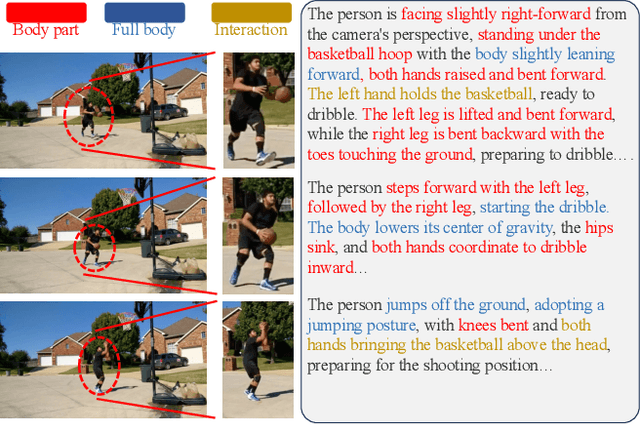
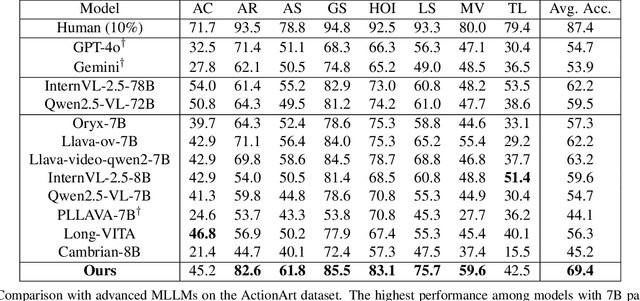

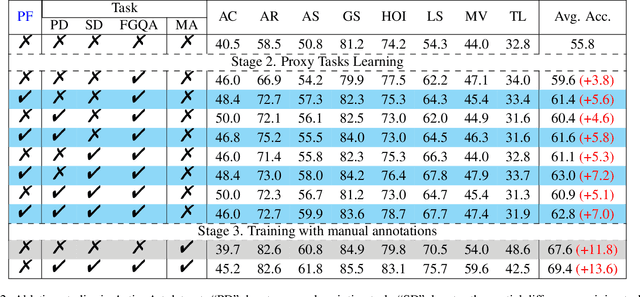
Abstract:Fine-grained understanding of human actions and poses in videos is essential for human-centric AI applications. In this work, we introduce ActionArt, a fine-grained video-caption dataset designed to advance research in human-centric multimodal understanding. Our dataset comprises thousands of videos capturing a broad spectrum of human actions, human-object interactions, and diverse scenarios, each accompanied by detailed annotations that meticulously label every limb movement. We develop eight sub-tasks to evaluate the fine-grained understanding capabilities of existing large multimodal models across different dimensions. Experimental results indicate that, while current large multimodal models perform commendably on various tasks, they often fall short in achieving fine-grained understanding. We attribute this limitation to the scarcity of meticulously annotated data, which is both costly and difficult to scale manually. Since manual annotations are costly and hard to scale, we propose proxy tasks to enhance the model perception ability in both spatial and temporal dimensions. These proxy tasks are carefully crafted to be driven by data automatically generated from existing MLLMs, thereby reducing the reliance on costly manual labels. Experimental results show that the proposed proxy tasks significantly narrow the gap toward the performance achieved with manually annotated fine-grained data.
ViSpeak: Visual Instruction Feedback in Streaming Videos
Mar 17, 2025

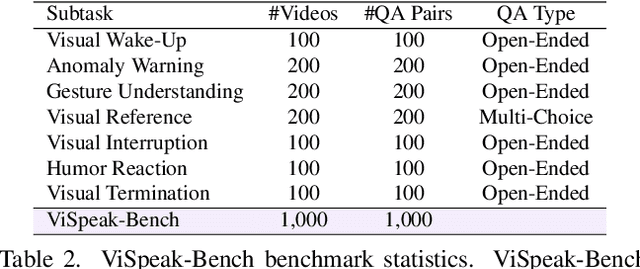
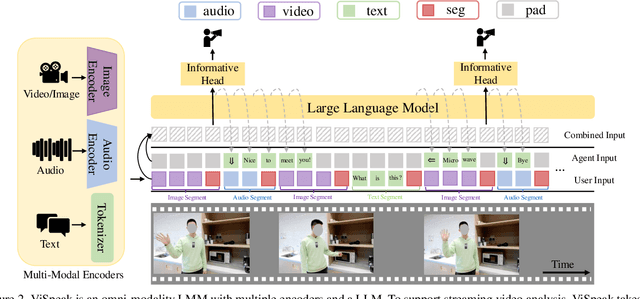
Abstract:Recent advances in Large Multi-modal Models (LMMs) are primarily focused on offline video understanding. Instead, streaming video understanding poses great challenges to recent models due to its time-sensitive, omni-modal and interactive characteristics. In this work, we aim to extend the streaming video understanding from a new perspective and propose a novel task named Visual Instruction Feedback in which models should be aware of visual contents and learn to extract instructions from them. For example, when users wave their hands to agents, agents should recognize the gesture and start conversations with welcome information. Thus, following instructions in visual modality greatly enhances user-agent interactions. To facilitate research, we define seven key subtasks highly relevant to visual modality and collect the ViSpeak-Instruct dataset for training and the ViSpeak-Bench for evaluation. Further, we propose the ViSpeak model, which is a SOTA streaming video understanding LMM with GPT-4o-level performance on various streaming video understanding benchmarks. After finetuning on our ViSpeak-Instruct dataset, ViSpeak is equipped with basic visual instruction feedback ability, serving as a solid baseline for future research.
A Hierarchical Semantic Distillation Framework for Open-Vocabulary Object Detection
Mar 13, 2025



Abstract:Open-vocabulary object detection (OVD) aims to detect objects beyond the training annotations, where detectors are usually aligned to a pre-trained vision-language model, eg, CLIP, to inherit its generalizable recognition ability so that detectors can recognize new or novel objects. However, previous works directly align the feature space with CLIP and fail to learn the semantic knowledge effectively. In this work, we propose a hierarchical semantic distillation framework named HD-OVD to construct a comprehensive distillation process, which exploits generalizable knowledge from the CLIP model in three aspects. In the first hierarchy of HD-OVD, the detector learns fine-grained instance-wise semantics from the CLIP image encoder by modeling relations among single objects in the visual space. Besides, we introduce text space novel-class-aware classification to help the detector assimilate the highly generalizable class-wise semantics from the CLIP text encoder, representing the second hierarchy. Lastly, abundant image-wise semantics containing multi-object and their contexts are also distilled by an image-wise contrastive distillation. Benefiting from the elaborated semantic distillation in triple hierarchies, our HD-OVD inherits generalizable recognition ability from CLIP in instance, class, and image levels. Thus, we boost the novel AP on the OV-COCO dataset to 46.4% with a ResNet50 backbone, which outperforms others by a clear margin. We also conduct extensive ablation studies to analyze how each component works.
LLMDet: Learning Strong Open-Vocabulary Object Detectors under the Supervision of Large Language Models
Jan 31, 2025



Abstract:Recent open-vocabulary detectors achieve promising performance with abundant region-level annotated data. In this work, we show that an open-vocabulary detector co-training with a large language model by generating image-level detailed captions for each image can further improve performance. To achieve the goal, we first collect a dataset, GroundingCap-1M, wherein each image is accompanied by associated grounding labels and an image-level detailed caption. With this dataset, we finetune an open-vocabulary detector with training objectives including a standard grounding loss and a caption generation loss. We take advantage of a large language model to generate both region-level short captions for each region of interest and image-level long captions for the whole image. Under the supervision of the large language model, the resulting detector, LLMDet, outperforms the baseline by a clear margin, enjoying superior open-vocabulary ability. Further, we show that the improved LLMDet can in turn build a stronger large multi-modal model, achieving mutual benefits. The code, model, and dataset is available at https://github.com/iSEE-Laboratory/LLMDet.
HumanOmni: A Large Vision-Speech Language Model for Human-Centric Video Understanding
Jan 25, 2025



Abstract:In human-centric scenes, the ability to simultaneously understand visual and auditory information is crucial. While recent omni models can process multiple modalities, they generally lack effectiveness in human-centric scenes due to the absence of large-scale, specialized datasets and non-targeted architectures. In this work, we developed HumanOmni, the industry's first human-centric Omni-multimodal large language model. We constructed a dataset containing over 2.4 million human-centric video clips with detailed captions and more than 14 million instructions, facilitating the understanding of diverse human-centric scenes. HumanOmni includes three specialized branches for understanding different types of scenes. It adaptively fuses features from these branches based on user instructions, significantly enhancing visual understanding in scenes centered around individuals. Moreover, HumanOmni integrates audio features to ensure a comprehensive understanding of environments and individuals. Our experiments validate HumanOmni's advanced capabilities in handling human-centric scenes across a variety of tasks, including emotion recognition, facial expression description, and action understanding. Our model will be open-sourced to facilitate further development and collaboration within both academia and industry.
Frozen-DETR: Enhancing DETR with Image Understanding from Frozen Foundation Models
Oct 25, 2024



Abstract:Recent vision foundation models can extract universal representations and show impressive abilities in various tasks. However, their application on object detection is largely overlooked, especially without fine-tuning them. In this work, we show that frozen foundation models can be a versatile feature enhancer, even though they are not pre-trained for object detection. Specifically, we explore directly transferring the high-level image understanding of foundation models to detectors in the following two ways. First, the class token in foundation models provides an in-depth understanding of the complex scene, which facilitates decoding object queries in the detector's decoder by providing a compact context. Additionally, the patch tokens in foundation models can enrich the features in the detector's encoder by providing semantic details. Utilizing frozen foundation models as plug-and-play modules rather than the commonly used backbone can significantly enhance the detector's performance while preventing the problems caused by the architecture discrepancy between the detector's backbone and the foundation model. With such a novel paradigm, we boost the SOTA query-based detector DINO from 49.0% AP to 51.9% AP (+2.9% AP) and further to 53.8% AP (+4.8% AP) by integrating one or two foundation models respectively, on the COCO validation set after training for 12 epochs with R50 as the detector's backbone.
Bridge Past and Future: Overcoming Information Asymmetry in Incremental Object Detection
Jul 16, 2024



Abstract:In incremental object detection, knowledge distillation has been proven to be an effective way to alleviate catastrophic forgetting. However, previous works focused on preserving the knowledge of old models, ignoring that images could simultaneously contain categories from past, present, and future stages. The co-occurrence of objects makes the optimization objectives inconsistent across different stages since the definition for foreground objects differs across various stages, which limits the model's performance greatly. To overcome this problem, we propose a method called ``Bridge Past and Future'' (BPF), which aligns models across stages, ensuring consistent optimization directions. In addition, we propose a novel Distillation with Future (DwF) loss, fully leveraging the background probability to mitigate the forgetting of old classes while ensuring a high level of adaptability in learning new classes. Extensive experiments are conducted on both Pascal VOC and MS COCO benchmarks. Without memory, BPF outperforms current state-of-the-art methods under various settings. The code is available at https://github.com/iSEE-Laboratory/BPF.
ASAG: Building Strong One-Decoder-Layer Sparse Detectors via Adaptive Sparse Anchor Generation
Aug 18, 2023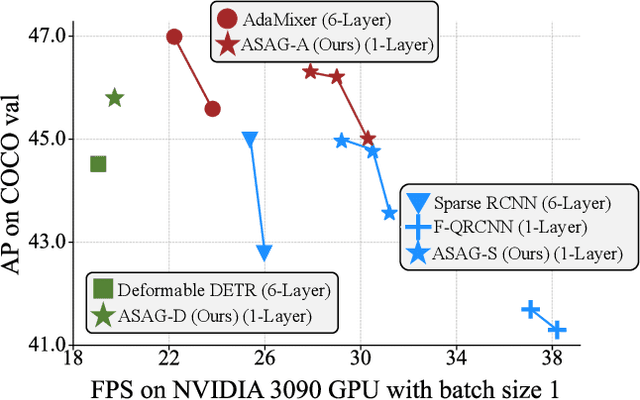

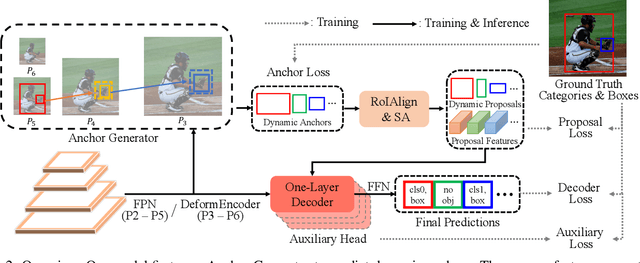

Abstract:Recent sparse detectors with multiple, e.g. six, decoder layers achieve promising performance but much inference time due to complex heads. Previous works have explored using dense priors as initialization and built one-decoder-layer detectors. Although they gain remarkable acceleration, their performance still lags behind their six-decoder-layer counterparts by a large margin. In this work, we aim to bridge this performance gap while retaining fast speed. We find that the architecture discrepancy between dense and sparse detectors leads to feature conflict, hampering the performance of one-decoder-layer detectors. Thus we propose Adaptive Sparse Anchor Generator (ASAG) which predicts dynamic anchors on patches rather than grids in a sparse way so that it alleviates the feature conflict problem. For each image, ASAG dynamically selects which feature maps and which locations to predict, forming a fully adaptive way to generate image-specific anchors. Further, a simple and effective Query Weighting method eases the training instability from adaptiveness. Extensive experiments show that our method outperforms dense-initialized ones and achieves a better speed-accuracy trade-off. The code is available at \url{https://github.com/iSEE-Laboratory/ASAG}.
 Add to Chrome
Add to Chrome Add to Firefox
Add to Firefox Add to Edge
Add to Edge